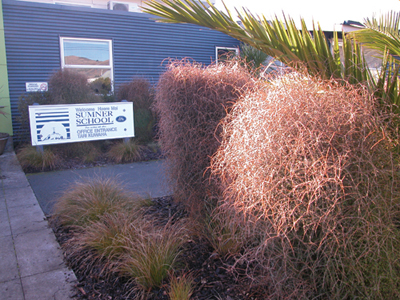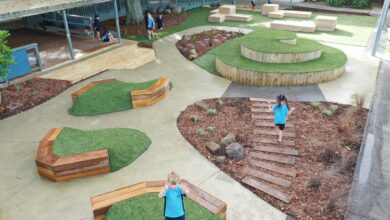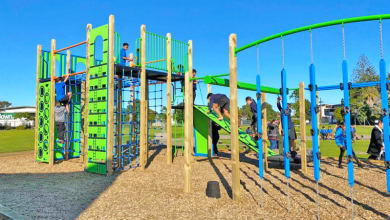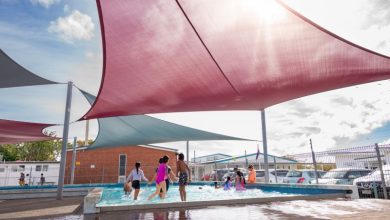Landscape planning for schools

 Most school landscapes develop over time as school rolls change and the school develops.
Most school landscapes develop over time as school rolls change and the school develops.
There is often a bit of an ad hoc approach to school outdoor spaces as the gardens must adapt to changes in the school with structures changing, including the building of new school buildings, and developments, such as new play grounds and outdoor sport areas, added into a pre-existing formula.
Schools are characterised by change, and planning dynamics for outdoor spaces are often left out of the formula.
Without considered planning these outdoor spaces can develop into a mishmash of school play and sport areas, pedestrian traffic corridors and amenity gardens. Development budgets are often constrained and ongoing maintenance costs are always an issue.
Professional landscape planning is essential to develop a garden that adds value and integrity to the school grounds. In domestic situations landscaping is recommended to be 10 – 15 per cent of the overall development budget for a new or existing home. With existing schools landscaping is often an after thought of the building process, however it should be integrated into the initial planning process with appropriate finances allocated to achieve desired goals. Professional landscape planning is money well spent. You wouldn’t dream of building a new school building without plans on paper so think of the school outdoor spaces in the same way.
Gardens link a school with the outside world and set the school into the surrounding environment. As often quoted “first impressions last”.
The first view most people will get of your school will be from the street with the school set into context within the garden and its surrounds.
Many of us see the buildings and gardens as separate entities and treat them as such. However, if we think of the inside and out as a single living environment then we will choose garden materials and furnishings that are compatible both with the school and its setting.
To ensure your school garden is well structured, and areas flow from one space to another, talk to a landscape designer or landscape architect to coordinate long term plans for the school buildings and gardens as an integral project.
Allocation of resources early on in any development or redevelopment design process allows for the most efficient use of time and money. There is nothing worse than finding that the large tree you wanted as a focal point of the school garden cannot be planted due to a lack of access after building. When remodelling a school garden take into account the outdoor spaces and what goals are to be achieved.
Features such as school entry and gathering areas; access ways for students; staff and parents; seating and lunch areas; play equipment and sports fields; specialised sports areas; shaded spaces; junior and senior areas; sand pits; swimming pools; and, more recently, fruit and vegetable gardens, are all design features that need to be well planned and executed to make the school run efficiently and safely.
Well designed and laid out school grounds and gardens can transform the school environment from the mundane to the special.
Be aware of the costs associated and capitalise on worthwhile and long lasting improvements.
Sustainable concepts add environmental value, teach students worthwhile living concepts and, in the long run, these sustainable concepts are usually very financially efficient.
Poor design is always poor, but objects, materials and systems that are well conceived will always relate well to one another in an entirely sympathetic way. The role of landscape designers is to produce a cohesive overall design to link indoor and outdoor spaces with the broader environment to fashion a quality product that will withstand the test of time.
Timely and appropriate landscape design is especially important for schools with difficult access so site works can be programmed into the building phase to conserve both physical materials and financial resources.
Good garden design is essentially simple and fit for its purpose. “Less is more” is a commonly repeated maxim that is frequently harder to achieve than say. How many of us wish for a simpler, less stressful life and then complicate things by having a mortgage, car payments, children and a raft of recreational pursuits? Such is modern life.
When “less is more” materials and details become more important as everything that is used must stand alone but be compatible with its accompanying pieces. Every material must be carefully chosen and appropriately used as it will be seen and the impact pronounced. The same can be said for gardens – simplicity is the key.
Current trends in school landscaping are the continued and pronounced use of New Zealand endemic plants; increasing numbers of schools with vegetable and fruit gardens; new playground styles and equipment; and the ongoing issues of school and student security, safety and health.
Appropriate and on going planning and incorporating appropriate design features can help to create a school environment that will flow, mature graciously over time, and add the maximum value to our most prized asset, our children; as schools are home for our children when they are not at the home they share with their parents.









